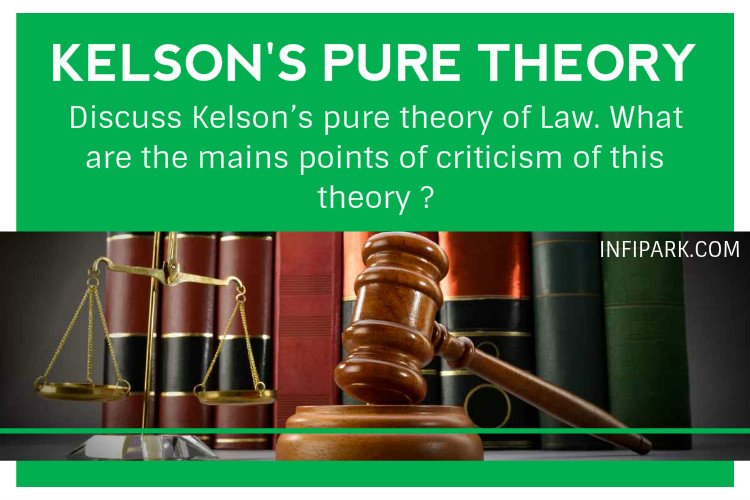Discuss Kelson’s pure theory of Law. What are the mains points of criticism of this theory ?
Or
Kelson “wishes to free the law from the metaphysical mist which it has been covered of all times.” Discuss.
Ans. Kelson did not favour widening the scope of jurisprudence by co-relating it with all social sciences and rigorously insisted on separation of law from politics„ sociology, metaphysics and all other extra-legal disciplines. It is quite often said that Kelson’s pure theory of law tried to rescue jurisprudence from vague mysticism and thus it was in a way revival of John Austin’s 19th century analytical jurisprudence. Like Austin, Kelson divested moral, ideal or ethical elements from law and wished to create a ‘pure’ science of law devoid of all moral and sociological co ‘nsiclerations. He rejected Austin’s definition of law as a command because it introduces subjective considerations whereas he wanted legal theory to be objective. Likewise, he also discards the, notion of justice as an essential element of law because many laws, though not just, may still continue as law. He defines ‘science’ as a system of knowledge or a ‘totality of congnitions.’ systematically arranged according to logical principles.
Law As Normative Science— Kelson described law as a “normative science’ as distinguished from natural sciences which are based on cause and effect, such as law of gravitation. The laws of natural science are capable of being accurately described, determined and discovered in the form of’is’ (das sain) which is an essential characteristic of all natural sciences. But the science of law is knowledge of what law ought to be (das-sollen). It is the ‘ ought character which provides normative character to law. For instance, if ‘A’ commits a theft he ought to be punished. Like Austin, Kelson also considers sanction as an essential element of law but he prefers to call it ‘norm’. Thus according to Kelson, ‘law is a primary norm which stipulates sanction’. It is called positive law because it is concerned only with actual and not with ideal law.
According to Kelson, ‘norm (sanction) is rules forbidding or prescribing a certain behaviour’. For him, legal order is the hierarchy of norths having sanction and jurisprudence is the study of these norms whk comprise legal order. He distinguishes moral norm with legal no. For example, moral norm says that ‘one shall not steal’ but since it has no punitive consequence, it lacks coercive force but if it is to be reduced I in form of legal norm, it would say, “if a person steals, he ought ‘to be punished by the competent organ or State”. This ‘ought’ in the legal norm refers to the sanction to be applied for violation of law.
The ‘Grundnorm’— Kelon’s pure theory of law is based on pyramidical structure of hierarchy of norms which derive their validity from the basic norm which he termed as ‘Grundnorm”. Thus, Grundnorm or basic norm determines the content and gives validity to other norms derived from it. Kelson has no answer to the question as to wherefrom the Grundnorm or basic nonn derives its validity. He considers it to be a meta-legal question in which jurist need not intrude. Commenting on this point, Julius Stone rightly comments that just as Austin’s sovereign in a particular society is a mere starting point for his legal theory, so also basic norm has to be accepted as a hypothetical starting point or fiction which gives a. legal system coherence and a systematic form.
Pyramid of Norms—Kelson considers legal science as a pyramid of norms with Grundnorm (basic norm) at the apex. The subordinate norms are controlled by norms superior to them in hierarchical order. The basic norm which is otherwise called Grundnorm is however, independent of any other norm being at the apex. The process of one norm deriving its power from the norm immediately superior to it, until it reafches the Grundnorm has been termed by Kelson as ‘concretisation’ of the legal system. Thus, the system of norms proceeds from downwards to upwards and finally it closes at the Grundnorm at the top. The Grundnorm is taken for granted as a norm creating organ and the creation of it cannot be demonstrated scientifically nor is it required to be validated by any other norm. For example, a statue or law is valid because it derives its legal authority from the legislative body, the legislative body in its own turn derives its authority from a norm i.e., the Constitution. As to the question from where does the Constitution derive its validity there is no answer and, therefore, it is the Grundnorm, according to Kelsonite conception of pure theory of law. In his view the basic norm is the result of social, economic, political and other conditions and it is supposed to be valid by itself.
The legal order as conceived by Kelson receives its unity from the fact that all manifold norms of which the legal system is composed can be traced back to a final source. This final source is the basic norm or the Grundnorm which he defined as “the postulated ultimate rule according to which the norms of this order are established and annulled, receive or lose their validity.








